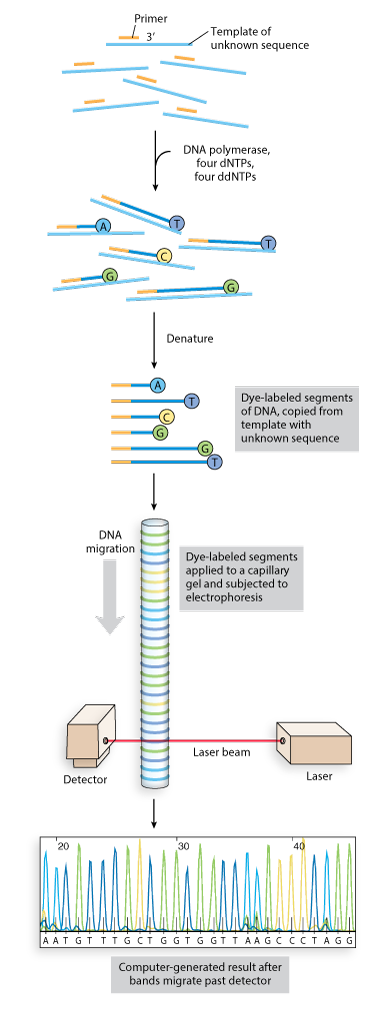Loading...

Prerequisite skills needed:
- Nucleotide Structure
- DNA Structure and Base Pairing
- Phosphodiester Bond Formation
- Relevant book section: pages 226-228
By completing this simulation, you will:
- Understand the underlying principles, chemical details and purpose of Sanger sequencing
- Simulate a sequencing reaction
- Identify ddNTP structure
- Analyze Sanger sequencing results, as a chromatogram, to pinpoint a mutation in the BRCA2 gene
Introduction to Sanger Sequencing
DNA synthesis involves a reaction between the oxygen in the 3'-hydroxyl group at the 3' end of the growing strand and the α-phosphate group of an incoming dNTP that is complementary to the next free nucleotide in the template strand. The Sanger method makes use of ddNTPs, which lack a 3'-hydroxyl group, to halt DNA synthesis at a particular nucleotide. In the sequencing reaction, DNA synthesis is carried out with a mixture of dNTPs and small amounts of ddNTPs. Each ddNTP can be linked to a fluorescent dye that gives the same color to all the fragments terminating in that nucleotide, a different color for each nucleotide. The resulting colored DNA fragments are separated by size in an electrophoretic gel in a capillary tube. All fragments of a given length migrate through the capillary gel together in a single band, and the color associated with each band is detected with a laser beam. The DNA sequence is read by identifying the color sequences in the bands as they pass the detector. Proceed to the exercise using the button at the bottom of this page.

The Sanger Sequencing Reaction
Detailed view of a Sanger sequencing reaction. There are fewer ddNTPs than dNTPs in the reaction mixture, so ddNTPs may take longer to appear.
Congratulations, you correctly terminated the DNA synthesis with a ddNTP. The ddNTPs interrupt DNA synthesis because they lack the 3'-hydroxyl group needed to form the next phosphodiester bond. Press the Continue button below to proceed with the exercise.
You failed to end the DNA synthesis with a ddNTP, press the try again button.
Sequence Analysis of the BRCA2 Gene
In this part of the exercise you will sequence a segment of Exon 5 of the BRCA2 gene. The DNA sample is from an individual heterozygous for a BRCA2 mutation. Your job at the end of the exercise will be to read the chromatogram and identify the nucleotide that is mutated in one of the patient’s BRCA2 alleles.

BRCA2 Fragment (sequence unknown)
Sequencing the BRCA2 Fragment
Close-up view of the sequencing reaction mixture.
When the sequencing reaction is complete, the mixture is run through a capillary electrophoretic gel. Note: for clarity, we show only the fluorescently-tagged DNA fragments entering the gel. In reality, the entire sample, template DNA included, is run through the gel. The fluorescent dyes associated with the different-sized fragments are detected by a laser as they exit the gel, generating the chromatogram below. You may need to scroll down to see the chromatogram.
Using the key, read the bases in this chromatogram. Enter your sequence in the box above. Then, drag-and-drop the rectangle selector onto the nucleotide position that is mutated in one of the individual’s BRCA2 alleles. Click Submit when you are finished.
Congratulations! You correctly read the chromatogram sequence and identified the mutated nucleotide. Click Continue to proceed.
Your submission is incorrect. Click Continue to proceed.
Analyzing the Sequence Results
| Wild type BRCA2 Exon 5: | |
| Sequenced BRCA2 Exon 5 Fragment (wild type allele): | |
| Sequenced BRCA2 Exon 5 Fragment (mutated allele): | |
| The sequence you entered: |
Congratulations, you finished the exercise! Your score shows you have a solid understanding of Sanger sequencing and sequencing analysis. Click the button below to begin the Tutorial Comprehension Quiz.
Congratulations, you finished the exercise! However, your score indicates you have some uncertainty with Sanger sequencing and sequencing analysis. Try the exercise again before taking the Tutorial Comprehension Quiz.
Congratulations, you finished the exercise! However, your score indicates your knowledge of Sanger sequencing and sequencing analysis is not adequate. Consider reviewing your text, and then try the exercise again before taking the Tutorial Comprehension Quiz.